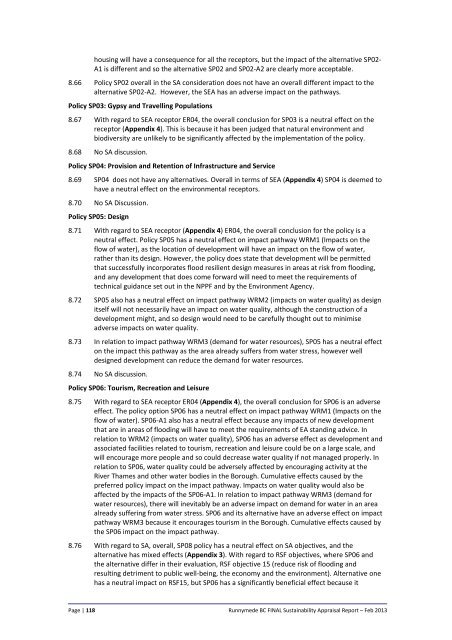DRAFT Sustainability Appraisal Report for the Emerging Local Plan ...
DRAFT Sustainability Appraisal Report for the Emerging Local Plan ...
DRAFT Sustainability Appraisal Report for the Emerging Local Plan ...
You also want an ePaper? Increase the reach of your titles
YUMPU automatically turns print PDFs into web optimized ePapers that Google loves.
housing will have a consequence <strong>for</strong> all <strong>the</strong> receptors, but <strong>the</strong> impact of <strong>the</strong> alternative SP02‐<br />
A1 is different and so <strong>the</strong> alternative SP02 and SP02‐A2 are clearly more acceptable.<br />
8.66 Policy SP02 overall in <strong>the</strong> SA consideration does not have an overall different impact to <strong>the</strong><br />
alternative SP02‐A2. However, <strong>the</strong> SEA has an adverse impact on <strong>the</strong> pathways.<br />
Policy SP03: Gypsy and Travelling Populations<br />
8.67 With regard to SEA receptor ER04, <strong>the</strong> overall conclusion <strong>for</strong> SP03 is a neutral effect on <strong>the</strong><br />
receptor (Appendix 4). This is because it has been judged that natural environment and<br />
biodiversity are unlikely to be significantly affected by <strong>the</strong> implementation of <strong>the</strong> policy.<br />
8.68 No SA discussion.<br />
Policy SP04: Provision and Retention of Infrastructure and Service<br />
8.69 SP04 does not have any alternatives. Overall in terms of SEA (Appendix 4) SP04 is deemed to<br />
have a neutral effect on <strong>the</strong> environmental receptors.<br />
8.70 No SA Discussion.<br />
Policy SP05: Design<br />
8.71 With regard to SEA receptor (Appendix 4) ER04, <strong>the</strong> overall conclusion <strong>for</strong> <strong>the</strong> policy is a<br />
neutral effect. Policy SP05 has a neutral effect on impact pathway WRM1 (Impacts on <strong>the</strong><br />
flow of water), as <strong>the</strong> location of development will have an impact on <strong>the</strong> flow of water,<br />
ra<strong>the</strong>r than its design. However, <strong>the</strong> policy does state that development will be permitted<br />
that successfully incorporates flood resilient design measures in areas at risk from flooding,<br />
and any development that does come <strong>for</strong>ward will need to meet <strong>the</strong> requirements of<br />
technical guidance set out in <strong>the</strong> NPPF and by <strong>the</strong> Environment Agency.<br />
8.72 SP05 also has a neutral effect on impact pathway WRM2 (impacts on water quality) as design<br />
itself will not necessarily have an impact on water quality, although <strong>the</strong> construction of a<br />
development might, and so design would need to be carefully thought out to minimise<br />
adverse impacts on water quality.<br />
8.73 In relation to impact pathway WRM3 (demand <strong>for</strong> water resources), SP05 has a neutral effect<br />
on <strong>the</strong> impact this pathway as <strong>the</strong> area already suffers from water stress, however well<br />
designed development can reduce <strong>the</strong> demand <strong>for</strong> water resources.<br />
8.74 No SA discussion.<br />
Policy SP06: Tourism, Recreation and Leisure<br />
8.75 With regard to SEA receptor ER04 (Appendix 4), <strong>the</strong> overall conclusion <strong>for</strong> SP06 is an adverse<br />
effect. The policy option SP06 has a neutral effect on impact pathway WRM1 (Impacts on <strong>the</strong><br />
flow of water). SP06‐A1 also has a neutral effect because any impacts of new development<br />
that are in areas of flooding will have to meet <strong>the</strong> requirements of EA standing advice. In<br />
relation to WRM2 (impacts on water quality), SP06 has an adverse effect as development and<br />
associated facilities related to tourism, recreation and leisure could be on a large scale, and<br />
will encourage more people and so could decrease water quality if not managed properly. In<br />
relation to SP06, water quality could be adversely affected by encouraging activity at <strong>the</strong><br />
River Thames and o<strong>the</strong>r water bodies in <strong>the</strong> Borough. Cumulative effects caused by <strong>the</strong><br />
preferred policy impact on <strong>the</strong> impact pathway. Impacts on water quality would also be<br />
affected by <strong>the</strong> impacts of <strong>the</strong> SP06‐A1. In relation to impact pathway WRM3 (demand <strong>for</strong><br />
water resources), <strong>the</strong>re will inevitably be an adverse impact on demand <strong>for</strong> water in an area<br />
already suffering from water stress. SP06 and its alternative have an adverse effect on impact<br />
pathway WRM3 because it encourages tourism in <strong>the</strong> Borough. Cumulative effects caused by<br />
<strong>the</strong> SP06 impact on <strong>the</strong> impact pathway.<br />
8.76 With regard to SA, overall, SP08 policy has a neutral effect on SA objectives, and <strong>the</strong><br />
alternative has mixed effects (Appendix 3). With regard to RSF objectives, where SP06 and<br />
<strong>the</strong> alternative differ in <strong>the</strong>ir evaluation, RSF objective 15 (reduce risk of flooding and<br />
resulting detriment to public well‐being, <strong>the</strong> economy and <strong>the</strong> environment). Alternative one<br />
has a neutral impact on RSF15, but SP06 has a significantly beneficial effect because it<br />
Page | 118 Runnymede BC FINAL <strong>Sustainability</strong> <strong>Appraisal</strong> <strong>Report</strong> – Feb 2013

















